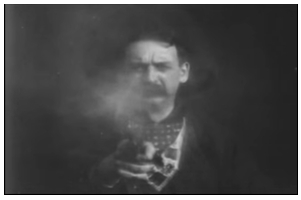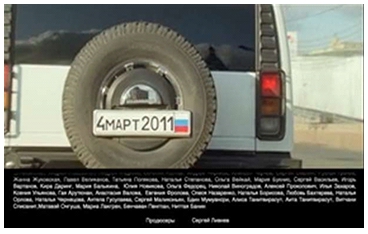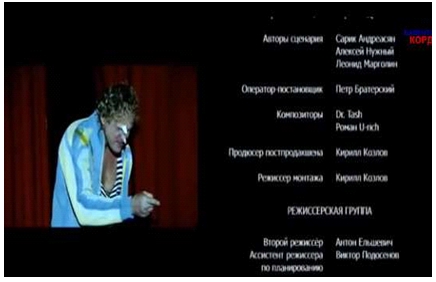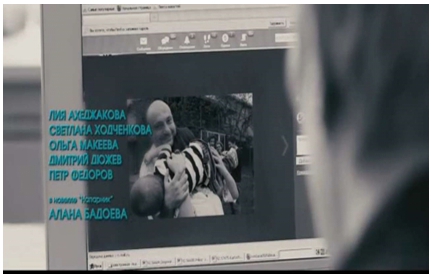БОНУСНЫЙ МАТЕРИАЛ КАК СОСТАВЛЯЮЩАЯ ФИНАЛЬНЫХ ТИТРОВ В СОВРЕМЕННОМ КИНОТЕКСТЕ
Колчина Т.Ф.1, Борисенко Е.Г.2, Кравченко О.А.3, Фомина Ж.В.4
1Аспирант, 2кандидат педагогических наук, доцент, 3кандидат филологических наук, 4кандидат филологических наук, Волгоградская государственная академия физической культуры, Волгоград, Россия
БОНУСНЫЙ МАТЕРИАЛ КАК СОСТАВЛЯЮЩАЯ ФИНАЛЬНЫХ ТИТРОВ В СОВРЕМЕННОМ КИНОТЕКСТЕ
Аннотация
В статье рассматривается понятие кинотекста и титров как его вербальной составляющей. Дается понятие бонусного материала как компонента финальных кинотитров. Автор выделяет сходства и различия в использовании бонусного материала как компонента финальных кинотитров в американской и русской лингвокультурах. Автор анализирует существующие подходы к тексту фильма и описывает его как полностью связанное сообщение, его лингвистические и индексальные характеристики. Статья представляет собой попытку проанализировать текст фильма как явление вербальных и невербальных компонентов.
Ключевые слова: кинотекст, кинотитры, финальные кинотитры, бонусный материал.
Kolchina T.F.1, Borisenko E.G.2, Kravchenko O.A.2, Fomina Zh. V.4
1Postgraduate student, 2PhD in Pedagogy, Associate professor, 3PhD in Philology, 4PhD in Philology, Volgograd State Physical Education Academy
POST-CREDIT SCENE AS A COMPONENT OF THE FINAL CREDITS IN A MODERN FILM TEXT
Abstract
The article deals with the concept of the film text and credits as its components. Post credit scenes as one of the final credits component in the film text are considered. Explores of the similarities and differences in the use of the post credit scenes as components of the final credits in American and Russian cultures are defined. The author analyses the existent approaches to the film text and describes it as a completely connected message and its linguistic and indexical characteristics. The article is an attempt to analyze the film text as a phenomenon of verbal and nonverbal components.
Keywords: film text, film credits, final credits, post credit scenes.
Cinematography – the branch of human activity, which consists in the creation of moving images, this is 1. a form of art whose works are created with the help of cinematography; 2. the branch of culture and national economy, which produces movies and shows them to the viewer. Cinematography was invented in the XIX century and became extremely popular in the XX century. The concept of cinema includes cinema art – a kind of modern visual art, whose works are created with the help of moving images, and film industry (the film industry) is the economic sector that produces movies, special effects for movies, animation, and demonstrates these works for viewers.
Movie is one of the youngest and at the same time one of the most popular arts. Major means of movie – image (shot on film people, events, objects, and landscapes) and audio (taped human speech, music, singing, and various noises).
A. V. Fedorov interprets the film text as the message expounded in any form (fiction, documentary, animation, educational, non-fiction) and cinema genre (drama, romance, comedy, detective, etc.) [9, P. 19]. T. A. Vinnikova defines this concept as “a dynamic communicative and meaning unity that occurs through the interaction of genetically heterogeneous (verbal and nonverbal) components. It is intended to visual-auditory perception, which is provided by the interaction of multi-level cognitive processes of reception” [1, P. 6]. Comprehensive linguistic definition was suggested by G. G. Slyshkin and M. A. Yefremova. They define the film text as “a connected, whole and complete message, expressed with verbal (linguistic) and nonverbal (iconic and / or indexical) signs in accordance with the design of the collective functionally differentiated author with the help of cinematographic codes, fixed on a material medium and intended for reproduction on the screen and the audiovisual perception by spectators” [7, P. 153].Modern researchers unanimously say that the film text is always a kind of collective work since the product involved the whole staff crew. The most important constitutive feature of the film text is a collective, functionally differentiated author. Collective authorship is one of the most important differences between the film text and, for example, literary text, despite the fact that the literary text can also be a result of the authors activities. Literary text does not differentiate authorship, while in addition when the collective author observed functional differentiation - we know who wrote the script, made costumes, played the roles of, written music, etc [7, P. 25-26].
Film text is a complex phenomenon, an integral part of the verbal and nonverbal components. Film text’ non-linguistic (non-verbal) system includes the iconic and indexical signs. It also has the audio portion, which incorporates the natural noise (rain, wind, footsteps, voices of animals and birds), technical noises and music. In addition, non-linguistic system includes the visual footage such as characters’ movements, scenery, props, and special effects [7, P. 153].
The subject of our study is the credits as one of the verbal components of the film text. Explanatory dictionary of S. I. Ozhegov and N. Yu. Shvedova identifies the caption as “the inscription on the shot in the movie” [5]. “The unabridged explanatory dictionary of Russian language” edited by D. N. Ushakov offers more precise definition: credits – an inscription containing an explanatory text or conveying the words of actors in the film (movie) [8]. In the future we will stick to this concept.
Credits are divided into initial (screen credits, main credits, opening credits), intratexual (intraframe) and final (closing credits, end credits) [3, P. 165]. The problem of our research is to examine the final credits and the phenomenon of bonus material as its component. The final credits in modern films – this is usually an expanded version of the initial credits [2, P. 46]. In addition to the name of the movie and the production company, the names of the members of the authors’ collective, all persons who to some extent related to this film are mentioned. The main (compulsory) information is often presented in the form of static credits (names of the main actors/famous actors, names of actors who played a cameo role, scriptwriter, but minor (less important) one – dynamic credts, scrolling, usually from the bottom up (the people who took part in making the film, words of gratitude, the company provided cellular communications, transport, props, etc.).
In the late 70-ies the US trade-unions insisted on the necessity to indicate in credits all the employees who participated in making the movie. Since then, the duration of the American final credits has considerably increased and was 4-8 minutes. The credits of American-Italian movie “Once Upon a Time in America” (dir. Sergio Leone, 1984) were 12 minutes of screen time and were listed in the Guinness book of records as the longest title. The audience was little interested in such information, they left the movie hall with the first sounds of final music and the final titles scrolled already in the empty hall. With the aim of attracting the viewers’ attention to movie credits, the moviemakers invented new interesting ways of attracting the viewer’s attention to the big screen – interesting music accompaniment and soundtracks, unusual visuals effects (font, background, color, size, position, computer graphics), post credit scenes.
Post-Credits Scenes are small comic scenes (“We're the Millers”, dir. Rawson Marshall Thurber, 2013; “Liar, Liar”, dir. Tom Shadyac, 1997), doubles of actors’ mistakes or funny outtakes (“The Rush Hour”, dir. Brett Ratner, 1998; “Bruce Almighty”, dir. Tom Shadyac, 2003), scenes that are not included in the movie (“Viy”, dir. Oleg Stepchenko, 2014), scenes that hint at movie continuation or completely change its meaning (“Pirates of the Caribbean: On Stranger Tides”, dir. Rob Marshall, 2011) or scenes that are formal (not informal) ending of the movie (“Me, Myself & Irene”, dir. Bobby and Peter Farrelly 2000), lasting from 2-3 seconds to 2 minutes, scrolling during and/or immediately after the final credits. It is unknown when and who invented this technique, however, we can trace the sequence of its use in various movies. One of the first post credit scenes appeared in 1903, when Edwin Porter filmed the classic Western “The Great Train Robbery” (Fig. 1).
Fig. 1 – “The Great Train Robbery”, dir. Edwin Porter, 1903
There are no credits in this film, as in many other silent films of that period. The picture has largely been innovative: for the first time the story involved more than one line, a parallel montage was used (when events are shown occurring simultaneously, but in different places), and at the end of the movie extra scene was especially filmed. “The Great Train Robbery” accompanies the viewer by shooting the main character in the screen. After almost 90 years the tribute of history gave Martin Scorsese used in “Goodfellas” 1990) the exact same method - Joe Pesci shot in the audience this time.
Full incremental scene as we know it, appeared only in the late seventies in the movie “The Muppets” (dir. James Frawley, 1979). Red furry creature shouted to the audience: “Go home. Go home. Bye-bye!”. Later post credit scenes are often used in comedies and horror films. Often an extension of the scene was used to make a joke or to scare finally.
Post credit scenes lacking the metafictional aspects also gained prominence in the 1980s, although they were still primarily used for comedy films. Post-credits scenes became useful places for humorous scenes that would not fit in the main body of the film. Using humor in such scenes is also still common for more serious films, as in the film “Daredevil”, (2005) in which Bullseye is shown after his defeat by Dared evil in a full body cast.
In Soviet movie “Carnival night” (dir. Eldar Ryazanov, 1956), after the word “the End” the acting Director of the Palace of Culture Serafim Ivanovich Ogurtsov with the words: “Comrades! Wait a minute, comrades! I officially declare that for all that was here today, I personally do not bear any responsibility”.
In the second movie about James Bond “From Russia with Love” (dir. Terence Young, 1963) at the beginning of the final titles, after “The End” follows “Not quite The End”, and further declares that "James Bond will return in the next Jan Fleming thriller "Goldfinger". These are only the first examples that were the beginning of the era of Post-Credit Scenes in the world moviemaking.
In modern cinema post credit scenes are used by American Directors more often. It’s all four-part “Pirates of the Caribbean” (2003, 2006, 2007, and 2011), where after the credits there are scenes hinting at a sequel or further development of the plot. Post credit scene is an integral part of “Marvel Motion Picture Company” movie production, specializing in shooting films based on comics. This company turned the teasers after the final credits of a few seconds into the present art. Post credit scenes of “Marvel Motion Picture Company” equally popular and anticipated than the movies themselves. It includes a huge list of movies. These are just some of them:
- “Iron Man” (dir. Jon Favreau, 2008) is one of the first movies of this motion picture company, in which there are references to other films made later;
- “X-Men” (all parts–2000, 2003, 2006, 2009, 2011, 2013, 2014, 2016, 2017), “The Incredible Hulk” (dir. Louis Leterrier 2008), are movies in which post credit scenes develop the plot of subsequent ones.
- But some of them just serve to entertain the audience.
- Sometimes post credit scenes show the future of the main characters. So in the movie “The Grey” (dir. Joe Carnahan, 2012) in a post-credits scene shows that the protagonist Liam Neeson overcame the wolf and survived.
As previously noted, some post credit scenes are the final scenes in the movie, that is a kind of “curtain” like in the movie “Me, Myself & Irene” (2000), where, after all credits there is a scene in which the heroes once again are looking for a shot off finger of Jim Carrey’s heroin the water. One of the characters finds it in the murky water and reports to his friends about it, but he sees how the fish swallows the finger.
In the final credits of the animated movie “Frozen” (dir. Chris Buck and Jennifer Lee, 2013), there is a statement, unrelated to the team of contributors. It performs an attractive function, although it is in a weak position and scrolls on a black background. Only the attentive viewer will be able to see a reference to the plot of the film in the inscription and see the humor. In this plot the main characters Anna and Christophe scale the peak of the North Mountain in search of Elsa, the Ice Queen. Anna confesses that she is in love with Gantz, even though they do not know each other. Christophe scoffs at her and says, “what if you don’t like how he eats? What if you don’t like the way he picks his nose ... and then he eats boogers? All men do it”. But in the credits, the creators have inserted the following disclaimer: “All opinions and thoughts expressed by Christophe in the movie that all men eat their boogers are solely his own and do not necessarily reflect the personal judgments of moviemakers and workers of the Studio “Disney”.
In the same work after the final credits survived after the fall Marshmallow (the snow monster created by Elsa) is returned in the deserted ice palace. His leg is already restored, the snow monster finds an abandoned Elsa's crown and puts it on his head, smiles and calms down. As a result his claws, spikes and fangs immediately retract. This way the authors use multiple ways to attract the attention of the audience.
The credits of many Pixar films, including “A Bug's Life” (1998), “Inside Out” (2015), and “Finding Dory” (2016) have included comedy. Other Pixar films, such as “Cars” (2006) and “Toy Story 3” (2010) have included an epilogue that plays during the credits.
In Russian cinema the post credit scene is paid not so much attention as in American one. Among modern movies one can be noted such films as “Love in the big city 2” (dir. M. Weisberg, 2010), where at the beginning of the final credits there is the scene of St. Valentine and his assistant conversation. The guy says, “I think we overdid it. Once everything is sweet over” St. Valentine replies, “And whatever gave you the idea that all ended? It’s just the beginning...” and the car is driving off and on the back license plate there is a visible inscription “4 March 2011”, it is an expected release date of this movie’s third part (Fig. 2).
Fig. 2 – “Love in the big city 2” (Любовь в большом городе 2), dir. M. Weisberg, 2010
Similar to American comedies in the movie “Mugs: the first episode” (dir. Sarik Andreasyan, 2009) on one side of the screen film titles scroll and on the other side the viewer sees bloopers cut from the film (Fig. 3). This technique reminds viewers of the movies with the participation of Jackie Chan (for example, “The Rush Hour 3”, dir. Brett Ratner, 2007), in which working scenes and stunts performing by Jackie Chan himself are scrolled on the dynamic background of the final credits.
Fig. 3 – “Mugs: the first episode” (Лопухи: эпизод 1), dir. Sarik Andreasyan, 2009
The same can be said about the movie “Viy” (dir. Oleg Stepchenko, 2013) and “The Bridegroom” (dir. Aleksandr Nezlobin, 2016). These movies aren’t featured by funny outtakes but by work stories which were not included in the picture.
In the film “Mothers” (dir. E. Abyzov, S. Andreasyan, A. Badoev, 2012) strong positions of the final titles scrolled on the background of the off-screen voice, telling about the mothers’ experiences for their children, and shots, showing the intensity of such feelings as love of parents to children (Fig. 4).
Fig. 4 – “Mothers” (Мамы), dir. E. Abyzov, S. Andreasyan, A. Badoev, 2012
These shots aren’t outtakes or deleted scenes of the movie, they are taken from a variety of videos (movies, commercials, home video) which are not associated absolutely with the movie.
Analyzing materials of movies with the post credit scenes we came to the conclusion that they can be divided into following groups:
- frames, hinting at a continuation of the movie’s plot;
- failed or working scenes;
- jokes, scary scenes or shots that are not related to the content of the film;
- footage showing the fate of the characters;
- interesting inscriptions.
In such a way we came to the conclusion that post credit scenes are actively used in modern American cinema to draw attention to the final titles, at the time, as in the Russian movie industry, this phenomenon begins only to be developed and implemented in the movie pictures. We also consider it’s necessary to note that in recent years the titles intentionally devalued on the television, by force of the high cost of screen time. They are transferred to a running line (demonstrate with a fast speed), and shots with post credit scenes, which was proposed by the movie authors with the intention that the recipient has watched the movie until the end, is transferred to the stronger position of the text, that is presented immediately after the plot of the film – before film text credits – but not afterwards, as it happens in theaters. Therefore, the post credits scenes on television cease to be a guarantee that the credits will be viewed by the recipient until the end.
Список литературы / References
- Винникова Т.А. Моделирование механизмов понимания кинотекста: автореф. дис. на соиск. учен. степ. канд. филол. наук (10.02.19) / Татьяна Александровна Винникова; Алт. гос. ун-т. – Барнаул, 2010. – 21 c.
- Колчина Т.Ф. Тенденции в англоязычном и русскоязычном тексте кинотитров при описании коллективного автора / Т.Ф. Колчина // Международный научно-исследовательский журнал. – 2017. – №4 (58) Ч. 2. – Екатеринбург: ИП Соколова Марина Владимировна. – С. 43-47.
- Колчина Т.Ф. Титры в англоязычных и русскоязычных кинотекстах 1930-х годов / Т.Ф. Колчина // Инициативы XXI века. – 2012. – № – М.: Институт бизнеса, психологии и управления. – С. 164-166.
- Колчина Т.Ф. Эволюция рамочных элементов кинотекста / Т.Ф. Колчина // Экономические и гуманитарные исследования регионов. – 2014. – № – Р. н/Д.: ЗАО «Центр Универсальной Типографии». – С. 30-33.
- Ожегов С. И., Шведова Н. Ю. Толковый словарь русского языка [Электронный ресурс] / С. И. Ожегов, Н.Ю. Шведова. - 4-е изд., доп. — М.: ООО «А ТЕМП», 2006. — 944 с. – URL: http://bookre.org/reader?file=52785 (дата обращения: 06.2017).
- Пономарева О.А., Столбова Е.Г. Риторико-семантический анализ политического имиджа в российских и американских СМИ / О.А.Пономарева, Е.Г. Столбова // Вестник Челябинского государственного университета. Серия: Филология. Искусствоведение. Вып.55 – 2011. – №17 (232). – С. 132-137.
- Слышкин Г.Г., Ефремова М.А. Кинотекст (опыт лингвокультурологического анализа) / Г.Г. Слышкин, М.А. Ефремова. – М.: Водолей Publishers, 2004. – 153 с.
- Толковый словарь русского языка: в 4 т. [Электронный ресурс] / Под ред. Д.Н. Ушакова. – М.: Гос. ин-т “Сов. энцикл.”; ОГИЗ; Гос. изд-во иностр. и нац. слов., 1935-1940. - URL: http://ushakovdictionary.ru/ (дата обращения: 15.05.2016).
- Федоров А.В. Словарь терминов по медиаобразованию, медиапедагогике, медиаграмотности, медиакомпетентности / А.В.Федоров. – Таганрог: Изд-во Таганрог. гос. пед. ин-та, 2010. – 64 c.
- Фомина Ж.В. Текстовая реализация концептосферы «возраст» в русской и американской молодёжных лингвокультурах / Ж.В. Фомина // Вестник Челябинского государственного университета. Сер. Филология. Искусствоведение.– Вып. 8 (223). – Челябинск, 2011. – С. 141-147.
Список литературы на английском языке / References in English
- Vinnikova T. A. Modelirovanie mehanizmov ponimania kinoteksta [Modeling mechanisms of comprehension of film text]: avtoref. dis. na soisk. uch. step. PhD. in Philology (10.02.19) / Vinnikova Tat'jana Aleksandrovna; Altay State University. – Barnaul, 2010. – 21 p. [In Russian]
- Kolchina T.F. Tendencii v anglojazychnom i russkojazychnom tekste kinotitrov pri opisanii kollektivnogo avtora [Trends in English and Russian Text of Titles at Description of Team of Contributors] / T.F. Kolchina // Mezhdunarodnyj nauchno-issledovatel'skij zhurnal [International Research Journal]. – 2017. – №4 (58) P. 2. – Еkaterinburg: IP Sokolova Marina Vladimirovna. – P. 43-47. [In Russian]
- Kolchina T.F. Titry v angloyazichnykh i russkoyazychnyh kinotekstah 1930-h godov [Titles in English-language and Russian-language Film Texts of the 1930s] / T.F. Kolchina // Iniziativy XXI veka [Initiatives of the XXI century]. – 2012. - №3. – M.: Institut of Business, Psychology and Management. – P. 164-166. [In Russian]
- Kolchina T.F. Evoliuziya ramochnykh elementov kinoteksta [Evolution of Frame Elements in Film Text] / T.F. Kolchina // Ekonomicheskiye i gumanitarnye issledovaniya regionov [Economic and Humanitarian Studies of Regions]. – 2014. - №4. – R. n/D.: ZAO “Centre for Universal Printing”. – P.30-33. [In Russian]
- Ozhegov S. I., Shvedova N. Ju. Tolkovyj slovar' russkogo jazyka [Dictionary of the Russian language] [Electronic resource] / S. I. Ozhegov, N. Yu. Shvedova. - 4-e izd., dop. – M.: OOO “A TEMP”, 2006. — 944 p. – URL: http://bookre.org/reader?file=52785 (accessed: 24.06.2017). [In Russian]
- Ponomareva O.A., Stolbova E.G. Ritoriko-semanticheskij analiz politicheskogo imidzha v rossijskih i amerikanskih SMI [Rhetorical Semantic Analysis of Political Image in the Russian and American Media] / A. Ponomareva, E.G. Stolbova // Vestnik Cheljabinskogo gosudarstvennogo universiteta. Serija: Filologija. Iskusstvovedenie. Vyp.55 [Bulletin of the Chelyabinsk State University. Series: Philology. The History of Art. Vol.55]. – 2011. – №17 (232). – P. 132-137. [In Russian]
- Slyshkin G.G., Yefremova M.A. Kinotekst (opyt lingvokulturologicheskogo analiza) [Film text (experience of linguocultural analysis] / G.G. Slyshkin, M.A. Yefremova. – M.: Aquarius Publishers, 2004. -153 p. [In Russian]
- Tolkovyj slovar' russkogo jazyka: v 4 t. [Electronic resource] / Ed. by N. Ushakov. – M.: Gos. in-t “Sov. jencikl.”; OGIZ; Gos. izd-vo inostr. i nac. slov., 1935-1940. - URL: http://ushakovdictionary.ru/ (accessed:15.05.2016). [In Russian]
- Fedorov A.V. Slovar terminov po mediaobrazovaniu, mediapedagogike, mediagramotnosti, mediakompetentnosti [Media Education Dictionary: Media Education, Media Literacy, Media Studies, Media Competence.] / A.V. Fedorov. – Taganrog: Izdatel'stvo Taganrogskogo gos. ped. in-ta [Publishing house of Taganrog State Pedagogical Institute], 2010. – 64 p. [In Russian]
- Fomina Zh.V. Tekstovaja realizacija konceptosfery «vozrast» v russkoj i amerikanskoj molodjozhnyh lingvokul'turah [Text Implementation of Sphere of Concept “Age” in Russian and American Youth Linguistic Cultures] / Zh.V. Fomina // Vestnik Cheljabinskogo gosudarstvennogo universiteta. Ser. Filologija. Iskusstvovedenie.– Vyp. 8 (223) [Bulletin of the Chelyabinsk State University. Ser. Philology. Art. – Vol. 8 (223)]. – Chelyabinsk, 2011. – P. 141-147. [In Russian]




